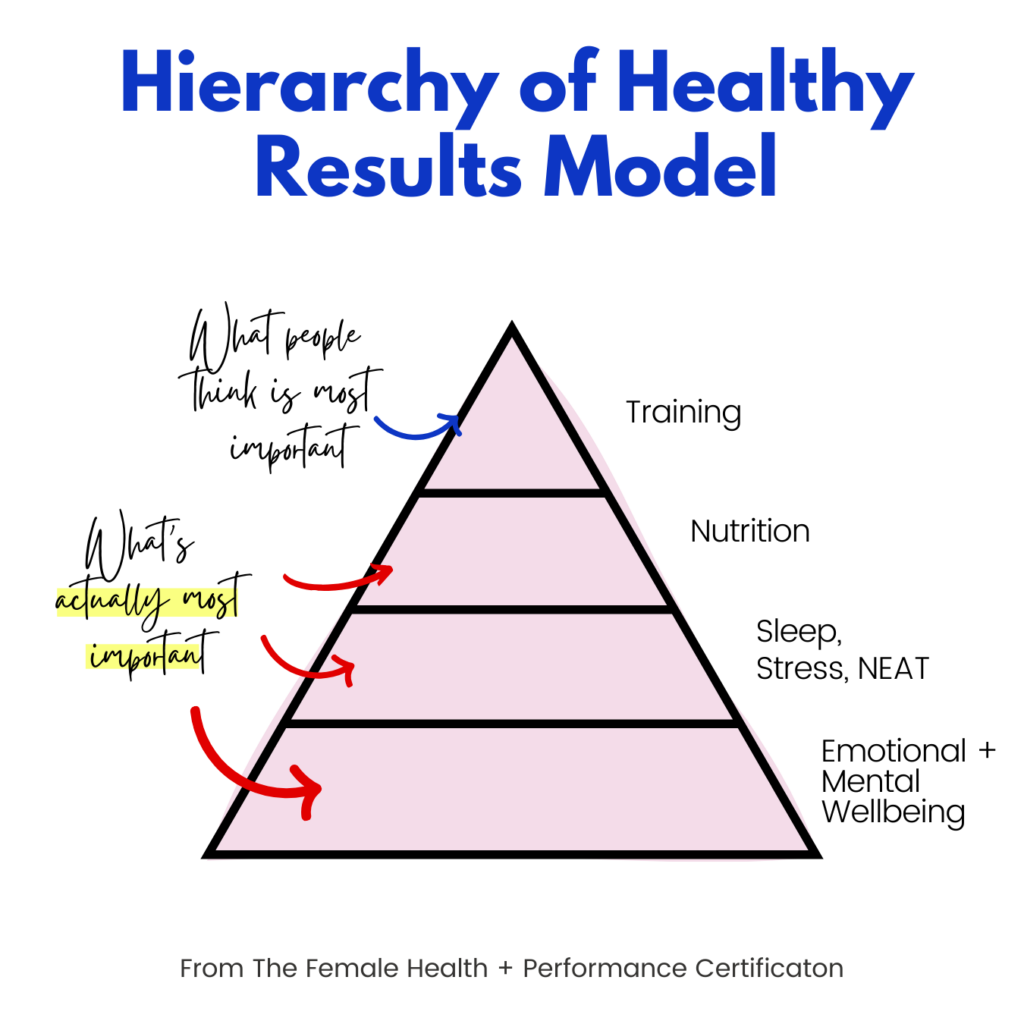The Modern Approach To Women’s Health and Performance
One of the good things to come out of those crazy Covid times is that people are now more conscious of their mental health, and health in general than before.
This means our clients are more sophisticated and want to go beyond the typical ‘focus on aesthetic’ goals that monopolised our industry for decades.
Women clients demand better services and want a holistic approach to their health and well-being.
And with so much advice readily available for women it’s up to us trainers to help them
a) discern the helpful information from disinformation, and
b) create programs that consider their whole being.
That’s why inside my Female Health + Performance certification I created an easy-to-understand model for FitPros to teach their clients, and for clients to learn how to connect the dots between their lifestyle choices and their results.
It’s called the Hierarchy of Healthy Results model, and in this episode, I briefly go over each step, and why it’s important.
Whether you are a fitness enthusiast or a veteran of the industry, this model will help you take a 360-degree approach to your health and ultimately performance.
The Hierarchy of Healthy Results At A Glance

The Hierarchy Of Healthy Results requires a different perspective
As mentioned in the show a foundation principle of the FH+P curriculum is the Hierarchy of Healthy Results model. However, using this model requires a new perspective.
In conventional personal trainer education, ‘fitness’ frameworks only include Training (and its components) and a hint of Nutrition education. Little attention or focus is given to other influential parts.
A significant criticism of a conventional framework is its one-dimensional nature and assumption that a person’s ability to achieve their goals is independent of external influences.
It is well known that nutritional choices impact a person’s results and health. Clients are aware of this connection but are less aware of the influence of other factors such as quality of sleep, stress management, sedentary behaviours, and emotional health.
To help a female client successfully achieve her goals, it is necessary to educate her on the relationship between them, allowing her to discover how crucial her lifestyle choices are outside of ‘purposeful exercise’ times.
The pyramid ascends in order of importance and impact. Emotional and mental health such as personal beliefs, self-efficacy, motivation, and self-determination have the most significant influence and impact on a client’s ability to achieve results.
The next most crucial level includes typical lifestyle choices and behaviours that impact her ability to cope with or manage stress, sleep hygiene, and volume of incidental activity. These factors directly influence hormones that influence metabolism, mood, and performance.
The nutrition level includes calories and energy balance factors and considers attitudes towards food/eating and nutritional behaviours.
Lastly, although still crucial in the big scheme of things, the least important part of this model is exercise or purposeful training.
A key point to remember is this; the quality of someone’s purposeful exercise is directly related to the quality of the factors preceding it. In other words, a client cannot ‘out-train’ a poor diet or expect high-quality exercise sessions (and adaptation) when stressed, tired, or not mentally available.
Another way to look at this is to view the bottom levels of the hierarchy as amplifiers.
When managed appropriately, these levels can amplify the positive impact of training.
Conversely, if not managed appropriately, they can become a huge roadblock and lessen the impact of training.
Helping the client become aware of this requires patience and long-term education.
A client cannot ‘out-train’ a poor diet or expect high-quality exercise sessions (and adaptation) when stressed, tired, or not mentally available.
Comments +